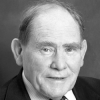Sydney Brenner

Sydney Brenner
Sydney Brenner CH FRS FMedSciis a South African biologist and a 2002 Nobel prize in Physiology or Medicine laureate, shared with Bob Horvitz and John Sulston. Brenner made significant contributions to work on the genetic code, and other areas of molecular biology while working in the Medical Research CouncilLaboratory of Molecular Biology in Cambridge, England. He established the roundworm Caenorhabditis elegans as a model organism for the investigation of developmental biology, and founded the Molecular Sciences Institute in Berkeley, California,...
NationalityBritish
ProfessionScientist
Date of Birth13 January 1927
It is now widely realized that nearly all the 'classical' problems of molecular biology have either been solved or will be solved in the next decade. The entry of large numbers of American and other biochemists into the field will ensure that all the chemical details of replication and transcription will be elucidated. Because of this, I have long felt that the future of molecular biology lies in the extension of research to other fields of biology, notably development and the nervous system.
My Uncle Harry had given me a microscope as a present which allowed me to continue my personal explorations of the living world.
My parents would have preferred me to become a surgeon or a physician but were most understanding of the ambitions of their son.
My parents were Jewish immigrants from Eastern Europe; my father came to South Africa from Lithuania in 1910, my mother, from Latvia, in 1922.
I went in with Jack and Leslie, into this room that was lined with brick, and there on the side I can remember very clearly was this small model with plates for the bases - the original model with everything screwed together.
During this period, I became interested in how the new techniques of cloning and sequencing DNA could influence the study of genetics and I was an early and active proponent of the Human Genome Sequencing Project.
The moment I saw the model and heard about the complementing base pairs I realized that it was the key to understanding all the problems in biology we had found intractable - it was the birth of molecular biology.
He told me that Francis Crick and Jim Watson had solved the structure of DNA, so we decided to go across to Cambridge to see it. This was in April of 1953.
I immediately began to read about bacterial viruses and in October 1952 I arrived in Oxford to do a Ph.D. in the Physical Chemistry Laboratory.
In my final year I failed Medicine, scraped through Surgery but got a First Class in the third subject, Obstetrics and Gynecology.
I spent 20 years sharing an office with Francis Crick and many new and exciting ideas (both right and wrong) were generated from our conversations.
I also became interested in chemistry and gradually accumulated enough test tubes and other glassware to do chemical experiments, using small quantities of chemicals purchased from a pharmacy supply house.
The modern computer hovers between the obsolescent and the nonexistent.
I lived at home and I cycled every morning to the railway station to travel by train to Johannesburg followed by a walk to the University, carrying sandwiches for my lunch and returning in the evening the same way.